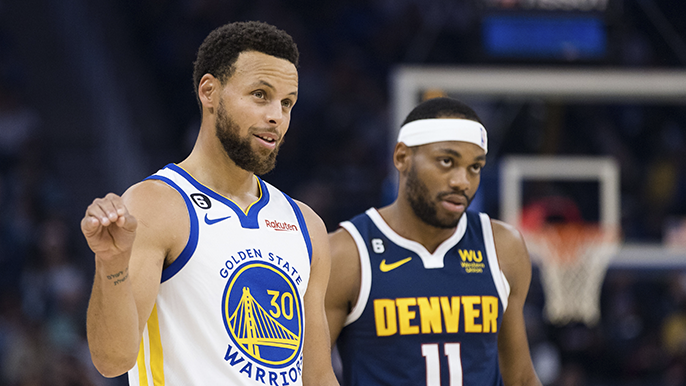
Forty-one-point-nine?
When ESPN senior writer Kevin Pelton input the data for his annual preseason projections, his algorithm spit out 41.9 wins for the Golden State Warriors — the eighth-most in the Western Conference and 17th overall.
The last time the Warriors finished with 42 or fewer wins in a full 82-game season was in 2011-12. They won 53 and their fourth NBA championship of the century last season. They return almost their entire core to defend their title this year. Vegas odds peg the Warriors as title favorites and set their over/under at 51.5 wins.
Even Pelton, who’s been working with statistics-based predictive models since 2008, admitted he was a “little” surprised by Golden State’s number.
“It’d be naive to just say ‘Oh, the projection system says this, therefore it must be right,’” Pelton told KNBR in a phone interview. “We have all this other information to consider — the general conventional wisdom, Vegas, etcetera. When you’re way off from that, it’s definitely a concern.”
On the day of the Warriors’ season-opener, which doubles as their championship ring ceremony, Golden State will get a chance to start proving the numbers wrong.
The ESPN projections account for SCHOENE player projections, regularized adjusted four-factors and health luck predictions. In more layman’s terms: recent player performance, team offensive and defensite ratings, and minutes projections based off games missed in the past.
There are a few forces at play for why Golden State’s win total is lower than logic — and Vegas — would indicate.
The only time the Warriors have really struggled in the past decade of the Stephen Curry era was in 2019-20, when Curry played five games and Klay Thompson missed the entire season due to injuries.
That season, though, is one wrench in their current ESPN projection. Pelton’s model takes into account performance from the previous three seasons, so that 15-50 year, and the 39-33 season that followed it, provide key data.
“I think it’s probably more of a factor of this unusual two-year gap out of the playoffs to back into championship contention with relatively the same core,” Pelton said.
Another potential factor, as Pelton noted in his column, is the departures of Otto Porter Jr. and Gary Payton II. Both players were key in last year’s run and are being replaced, ostensibly, with younger wings like Jonathan Kuminga and Moses Moody — players who may not have made much of an impact in the eyes of advanced statistics so far.
Then there’s the age element. Curry, Green and Thompson are in their 30s, and are complemented by in-their-prime Jordan Poole and Andrew Wiggins plus the unproven recent draftees. Still, the Warriors grade out as 10th in the model’s projected age, which weighs minutes played.
Historically, Pelton said, older teams tend to outperform their preseason projections. Part of that is because they’re typically more in win-now mode and are more likely to add to their roster midseason via trade or buyout.
“One of the big challenges about doing these projections is you’re doing it based on rosters on October 18,” Pelton said. “But you know that the rosters on April 18 are going to look very different.”
Pelton said an outlier projection like Golden State’s 41.9 wins makes him “definitely consider” tweaking the model. But it would be poor practice to adjust the algorithm just based on one team in lieu of the other 29.
“Because otherwise, I think you’re in danger of chasing something that is going to make your projections worse for everybody else,” Pelton said. “Then you run into the danger of kind of overfitting. So if a model says ‘well if you’ve won three of the last five championships, you get a bonus of X wins,’ it would help the Warriors but I don’t know if it would be that useful overall.”
Pelton’s model isn’t alone in doubting the 2022-23 Warriors. FiveThirtyEight’s signature algorithm, based on RAPTOR player ratings, pegs the Warriors as a 49-win team.
Last year in the Finals, FiveThirtyEight gave GSW just a 20% chance at beating the Celtics. That’s after their preseason model pegged Golden State as a 37-win team.
No model is going to be correct 100% of the time, yet it seems like the Warriors’ reality have been particularly detached from the projections recently.
Projections can be useful for setting expectations. But as soon as the ball is tipped at 7:00 p.m. in the Chase Center and the Warriors’ season gets rolling, theoretical wins and losses give way to real ones. And the Warriors know better than any team: the computers don’t award the Larry O’Brien.

